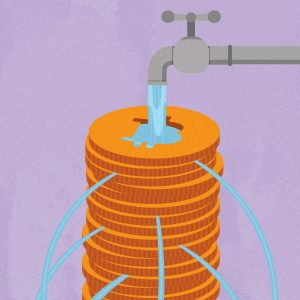Artificial intelligence data centers are becoming so ravenous for power that they threaten to max out electricity grids. Yet one of the technology’s least glamorous uses—finding ways to pinch pennies on energy bills in homes and commercial buildings—could ease the crunch.
Industry leaders think that AI has the potential to change everything from how cancer is diagnosed to the way advertising campaigns are created . But training AI models on huge data sets sucks up a lot of power. Even a simple ChatGPT request uses nearly 10 times more electricity than a regular Google search, according to the International Energy Agency. This week, the chief executive of chip-design company Arm warned that, unless energy savings are found, AI data centers could consume up to 25% of America’s power by 2030, compared with 4% today.
Ironically, using AI might be the best way to find these energy savings. And if the technology can fix one of humanity’s more mundane problems—how to keep air-conditioning units and lighting at an optimal setting at all times—it would make a significant dent in the amount of power used in buildings.
Real estate is a heavy and wasteful user of energy. According to the IEA, the operation of residential and commercial buildings accounts for 30% of global energy use, and about a third of that is squandered.

Wastefulness is often caused by crude building operating systems that set the heating or cooling facilities to come on and off at a specific time each day, regardless of the outside air temperature or how many people are using the building.
Offices have become especially inefficient. U.S. occupancy rates are stuck at around 50% of what they were in 2019 based on employee swipe-card data collected by Kastle Systems. New remote work patterns mean many offices empty out on Mondays and Fridays, but might still be powered the same way they have always been.
At an energy conference last month, Schneider Electric CEO Peter Herweck predicted that AI could reduce energy consumption in buildings by 15% to 25% over the next four years. As smart devices and meters have been fitted in more homes and commercial properties over the past decade, buildings now generate reams of data on such things as water heating and usage, occupancy numbers, and how the elevators operate.
By gathering this information in one place and analyzing it, organizations can use AI to spot where they can make energy savings, identify faults or predict future maintenance needs, and set a building’s operating system based on inputs such as the weather forecast and the number of people on site.
New buildings are increasingly designed for this level of accuracy. London-listed real-estate investment trust British Land uses AI in the operating systems of its newly constructed properties and plans to retrofit old locations over time. Sustainability is now one of its tenants’ top requirements, and surging energy costs triggered by Russia’s invasion of Ukraine in early 2022 have made Europe-based companies more sensitive to efficiency.
U.S. landlords have their own reasons to get buildings up to scratch. Guy Grainger , global head of sustainability for JLL , says that wasteful energy use could start to affect the value of buildings as more climate regulations come into force. New York City’s Local Law 97, which kicked in this January, will charge $268 per metric ton of CO2 equivalent emitted above a building’s carbon allowance.
Buildings’ energy consumption is still rising 1% a year globally, according to the IEA. To be on track for the agency’s net-zero scenario, real estate’s energy needs must fall 25% by 2030.
To get there, investment in energy efficiency for buildings needs to roughly double. In 2023, worldwide spending on power-saving measures in real estate reached $244 billion. This was 4% lower than in the previous year. Higher interest rates, as well as lower oil and gas prices, have slightly lessened the appetite to invest.
Still, upfront costs are being recouped quickly. Existing infrastructure doesn’t always have to be ripped out, but it might need better software to manage it. Aspiria, an innovation campus in Kansas, has reduced its energy consumption by 16% since 2019 after Schneider Electric helped to overhaul its building management system. The initial investment was clawed back within two years, thanks to a $1.5 million reduction in its annual energy bill, according to Schneider.
Shares in companies that run power plants have rallied hard this year because investors expect energy demand to surge to support new uses of AI. Vistra and Constellation Energy have risen 84% and 63%, respectively, since January, for example.
A contrarian bet would be to buy shares in companies—such as ABB , Siemens or Schneider Electric—that specialize in AI-enabled energy efficiency systems.
Power-saving efforts often get overlooked, maybe because they aren’t as exciting as shiny new clean-energy infrastructure. But energy efficiency is so formidable that the IEA nicknames it the “first fuel.” Saudi Aramco CEO Amin Nasser has also pointed out that efficiencies reduced global energy demand by 90 million barrels of oil equivalent a day over the past 15 years. The contribution from wind and solar energy has substituted just 15 million barrels a day by comparison.
AI is certain to turbocharge data centers’ power needs, but it also looks like the answer to offset this surge. Real estate is the obvious place to start a push to save energy.
Write to Carol Ryan at carol.ryan@wsj.com







